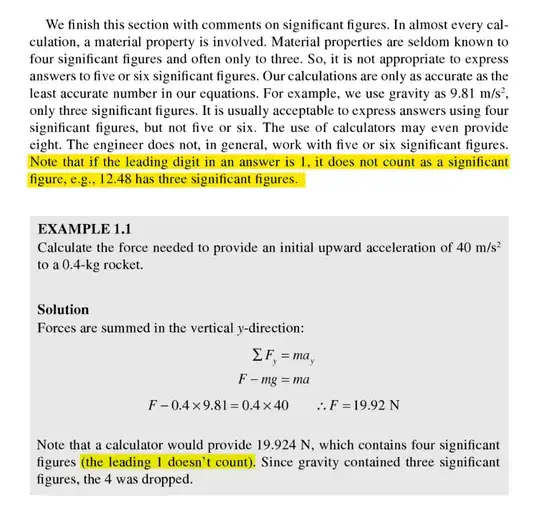It's Experiment Time!
(I was starting to see both points of view on whether to drop the 1, and was curious if there was some objective way of tackling the problem... so I figured it might be a good opportunity for an experiment. For Science!)
Assumptions: Significant Digits are a way of signifying precision on a number - either from uncertainty of measurement or as the result of calculations on a measurement. If you multiply two measurements together, the result has the same number of significant digits as the lower of the two starting values (so 3.8714 x 2.14 has three digits total, not seven like you'd get from plugging it into a calculator.)
That 'calculation' part is what I'd like to take advantage of. Because arguing significant digits on a number in a vacuum is just semantics. Seeing how the precision carries forward with actual operations gives an actual testable prediction. (In other words, this should remove any sort of 'cutoff' issue. If two numbers have X significant digits, then the multiplication of them should have an accuracy of roughly X significant digits - and the validity of the how you determine what's a significant digit should translate accordingly.)
Experimental Layout
Generate two high precision, Benford-compliant coefficients (I'm not actually sure Benford matters in this experiment, but I figured I shouldn't omit any possible complicating factors - and if we're talking physics, our measurements should be fit Benford's Law.) Perform an operation like Multiplication on them. Then, round those same coefficients down to 4 digits after the decimal, and perform the same multiplication on those rounded values. Finally, check how many digits the two resulting values have in common.
Aka, check how well the imprecise 'measurement' version compares the actual, hidden, high-precision calculation.
Now, in an ideal world, the value would be 5 matching (significant) digits. However, since we're just blinding checking whether digits match, we're going to have some that match by sheer luck.
Experimental Results For Multiplication
Digits Matching Where Result Doesn't Start With One
... and no input value starts with One:
5th digit matches 89.7%
6th matches 21.4%
... and one input value starts with One:
5th digit matches 53.7%
6th matches 5.57%
... and two input values start with One:
5th digit matches 85.2%
6th matches 11.1%
Digits Matching Where Result Starts With One:
... and no input value starts with One:
5th digit matches 99.9+%
6th matches 37.8%
... and one input value starts with One:
5th digit matches 99.9+%
6th matches 25.5%
... and two input values start with One:
5th digit matches 95.0%
6th matches 13.9%
Conclusions For Multiplication
First, multiplying two numbers and ending with a number that starts with 1, you should probably count the 1 as a significant digit. In other words, if you multiply '4.245' x '3.743', and come up with '15.889035', you should probably leave it at '15.89'. If you add an additional digit and call it '15.889', you have a 38% chance of that final digit being correct... which probably isn't high enough to be defensible to include.
But multiplying where one of the inputs starts with 1, and it gets strange. Multiplying '1.2513' x '5.8353', and realistically, you don't have five significant digits in your result. According to the experiment, you've got four digits... and a 54% chance of being right with that fifth value. Well, if a 38% chance in the prior situation (multiplying two numbers and ending with a value starting with '1') of getting an 'extra' significant digit isn't acceptable, then it's probably fair to say the 54% chance in this situation is also probably too low to justify including the 5th digit.
So you might be tempted to say "Don't treat a leading 1 as significant as an input to a calculation"... except that multiplying 1.##### x 1.#### (two numbers that start with 1) gives you 85.2% accuracy on that fifth digit - which is pretty much the same level of accuracy where none of the three numbers begin with a 1. So if 8.83 x 8.85 should have three significant digits, so should 1.83 x 1.85.
Final Conclusion: It's actually a deceptively difficult problem to figure out a good heuristic. Especially since there's a pretty big difference between a measurement of 1.045 that's fed into the input of a calculation, and the 1.045 that comes out as a result of a calculation. Which explains why there are multiple methods of handling leading 1's. (If I were forced to choose a Heuristic, it would be: don't count the leading '1' on any measurements performed, but count it for the output of any calculations.)
 I have searched and saw that practically the same thing is said in another book (Fluid Mechanics DeMYSTiFied):
I have searched and saw that practically the same thing is said in another book (Fluid Mechanics DeMYSTiFied):
